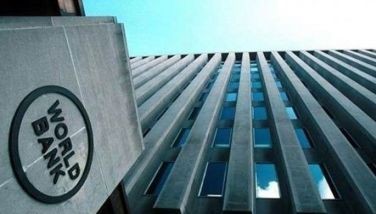Inflation eases to 13-mo low in Sept
October 6, 2005 | 12:00am
The nationwide inflation rate eased to a 13-month low in September on less costly energy prices, the National Statistics Office (NSO) reported yesterday.
The government statistics office said inflation rose at a slower seven-percent clip in September after climbing to 7.2 percent in August.
The September rate was the lowest since the 6.8-percent rise recorded in August 2004, the government statistics office said.
Despite the slowdown, Bangko Sentral ng Pilipinas (BSP) Governor Amando Tetangco Jr. said policy makers will "remain cautious," suggesting a further increase in benchmark overnight interest rates may be possible.
"While the moderation from the earlier months is as expected, there remain potential risks to inflation down the road such as the movement of oil prices," Tetangco said in a text message.
Faster inflation in the next few months may prompt the BSP to raise its benchmark rate for a third time this year, discouraging borrowing and investment and slowing growth.
Tetangco said the September figure was within its projected range of 6.6 to 7.1 percent but warned inflationary risks remain due to rising oil prices.
Month-on-month, prices in September were up 0.4 percent from August, when they rose 0.5 percent.
For the first nine months of the year, inflation averaged 7.9 percent in line with the government’s latest forecast for 2005 to be followed by 7.5 percent in 2006.
The government had previously expected rates of five to six percent and four to five percent, respectively.
Fuel, light and water prices increased 17.3 percent in September from a year earlier, compared with an 18.7 percent rise in the previous month.
Prices of food, beverages and tobacco rose 5.7 percent from 5.8 percent. Miscellaneous items, including household furnishings and equipment, increased 3.2 percent from a year earlier, matching the rise of the previous month.
Housing and repair costs were unchanged at 4.8 percent, the report said. Services, which include transport costs, were also steady at 10 percent.
The BSP on Sept. 22 raised its key overnight rate a quarter point to 7.25 percent from seven percent, the second
increase this year. The bank on April 7 increased the rate by a quarter point from a 13-year low.
Investors use the BSP rate as guide when bidding at government’s debt auctions.
The 91-day Treasury bill yield, used by banks as benchmark for setting loan rates, rose to 5.898 percent at this week’s auction, the highest since July 11.
Remittances from Filipinos working overseas may help boost consumer spending, offsetting the impact of higher interest rates, said Euben Paracuelles, an economist at DBS Group Holdings Ltd. in Singapore.
"Higher interest rates will not be too damaging on the economy,’’ Paracuelles said. "Remittances are expected to rise in the coming months because of the Christmas holidays and it will limit the negative impact of higher interest rates." –With reports from Donna Gatdula
The government statistics office said inflation rose at a slower seven-percent clip in September after climbing to 7.2 percent in August.
The September rate was the lowest since the 6.8-percent rise recorded in August 2004, the government statistics office said.
Despite the slowdown, Bangko Sentral ng Pilipinas (BSP) Governor Amando Tetangco Jr. said policy makers will "remain cautious," suggesting a further increase in benchmark overnight interest rates may be possible.
"While the moderation from the earlier months is as expected, there remain potential risks to inflation down the road such as the movement of oil prices," Tetangco said in a text message.
Faster inflation in the next few months may prompt the BSP to raise its benchmark rate for a third time this year, discouraging borrowing and investment and slowing growth.
Tetangco said the September figure was within its projected range of 6.6 to 7.1 percent but warned inflationary risks remain due to rising oil prices.
Month-on-month, prices in September were up 0.4 percent from August, when they rose 0.5 percent.
For the first nine months of the year, inflation averaged 7.9 percent in line with the government’s latest forecast for 2005 to be followed by 7.5 percent in 2006.
The government had previously expected rates of five to six percent and four to five percent, respectively.
Fuel, light and water prices increased 17.3 percent in September from a year earlier, compared with an 18.7 percent rise in the previous month.
Prices of food, beverages and tobacco rose 5.7 percent from 5.8 percent. Miscellaneous items, including household furnishings and equipment, increased 3.2 percent from a year earlier, matching the rise of the previous month.
Housing and repair costs were unchanged at 4.8 percent, the report said. Services, which include transport costs, were also steady at 10 percent.
The BSP on Sept. 22 raised its key overnight rate a quarter point to 7.25 percent from seven percent, the second
increase this year. The bank on April 7 increased the rate by a quarter point from a 13-year low.
Investors use the BSP rate as guide when bidding at government’s debt auctions.
The 91-day Treasury bill yield, used by banks as benchmark for setting loan rates, rose to 5.898 percent at this week’s auction, the highest since July 11.
Remittances from Filipinos working overseas may help boost consumer spending, offsetting the impact of higher interest rates, said Euben Paracuelles, an economist at DBS Group Holdings Ltd. in Singapore.
"Higher interest rates will not be too damaging on the economy,’’ Paracuelles said. "Remittances are expected to rise in the coming months because of the Christmas holidays and it will limit the negative impact of higher interest rates." –With reports from Donna Gatdula
BrandSpace Articles
<
>
- Latest
- Trending
Trending
Latest






















